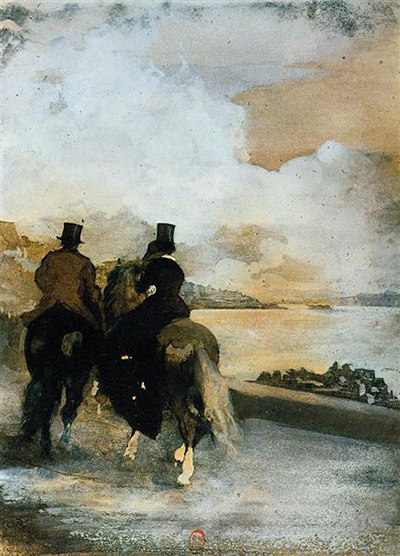Edgar Degas was a prominent 19th century French artist that incorporated endless realms of vision throughout his work. The artist is most prominently known for his ballerina adoration that gained him most success. Some of his most famous pieces include Group Of Dancers, Blue Dancers, and Ballet Scene.
These stunning artworks showcase the melodic movement of the female body through all its form and life. Degas captivated his viewer during his time and continues to do so today. While Degas often showcased ballerinas in his work, he often dabbled with pastel pieces of the nude female body. Some of these stunning pieces include Seated Bather, After The Bath, and The Toilette. The female body was one of the artist's focuses throughout his artwork as it had a mystical touch to it. The artist did not feel the same way in regard to the male body as it did not flow in endless curves as gently as a woman's did.
The artist did produce a few scenic paintings that showcased men on horses throughout his work. Some of these pieces include At The Races The Start, On The Racecourse, The Start Of The Hunt, and Racehorses At Longchamp. These pieces paid tribute to the prominent titles of men and those of the upper-class. Two Riders By A Lake had a similar touch throughout the work as it gently showcases a pair of men riding their horses along the lake. The interesting element to note throughout the work is that Degas decided to use a pen and ink duo to portray the piece. Rather than using oil paint or pastels, the artist found a new medium to produce he artwork in.
The group of men face away from the viewer as they ride into the distance. The perspective of the artwork is an overall centre point of view. The perspective seems to perfectly resemble that of a viewer looking onto the men, most likely Degas. Since the artist commonly depicted scenes that he saw throughout his life, this painting is most likely passed by two men that caught the artist's attention. Degas felt it was his job to transcend his life through his art. He sent messages and stories throughout his work that he wanted the viewer to capture. The artist's work is a manifestation of his perspective on life that he worked to imitate onto canvas. His art was an imitation of his life, rather than his life being an imitation of his art.
The captivating piece has a different touch to it based on the pen and ink tools Degas used throughout the piece. The work is based in three primary colours: blue, gold, and dark grey. The artist intertwined these colours through one another to create the piece, rather than substituting with any other colours. Since the artwork is created in a centre perspective, it's difficult to make out much detail. NeR the bottom of the artwork, a small paved road leads into the city on the left. The viewer is able to make out the city based in the tall buildings in the background. To the right, a large body of water fills that paper in shades of blue and white with touches of gold throughout.
Similar blue and golden shades fill the sky of the painting that takes up roughly half of the paper. The viewer is transcended by the stunning shades that intertwine with one another to produce the piece. It's immensely interesting to note the style in which Degas used to paint the sky of the artwork. While it is primarily covered in blue, a golden cloud adds depth to the sky. Near the upper brim of the artwork, dark grey specs seem to line the piece giving it a contour throughout. It's stunning to observe the beautiful colouring used throughout the painting, proving the masterful touch of Edgar Degas is alive through all paintings.




